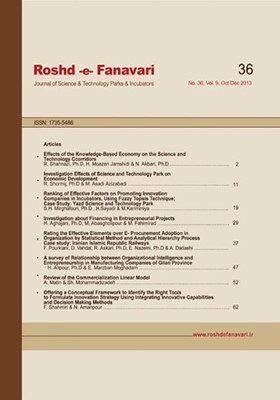Review of the Commercialization Linear Model
Subject Areas : Technology Transfer and Commercialization of ResearchesAyda Matin 1 , Shadi Mohammad zadeh 2
1 -
2 -
Keywords: Commercialization, Commercialization Linear Models, Technology, Technical Knowledge, Research Findings,
Abstract :
The master key of the world today is the creation of value. The entry approach to the today’s business world is technology and the master key of the technology is commercialization and value added created by it. Commercialization is the conversion process of the new technologies to the commercially successful products. Commercialization is containing different arrays of technical, commercial and financial process which converts the new technology into the useful products or services. In other word, commercialization of research findings is the link between technology and market and the focus of it is on the end rings of value chain. Since delivering a product to the market can be the guarantee of organization success and survival, commercialization, the technical knowledge is known as a vital factor. In research organizations, research doesn’t have meaning without product commercialization. Because producing or testing an idea seems useless without access to the product special customers. In order to apply the concept of commercialization in organizations, it’s necessary to be familiar with the commercialization models. A classification of commercialization models are classified into two categories: linear and functional. Due to the importance of linear models, in this article after checking the concept of commercialization, we will check the most important commercial linear models. The linear models are the Goldsmith, Kokobu, Cooper, Rothwell & Zegfeld model, Andrew & Sirkin, Jolley, and the Yeong–Deok Lee models.


